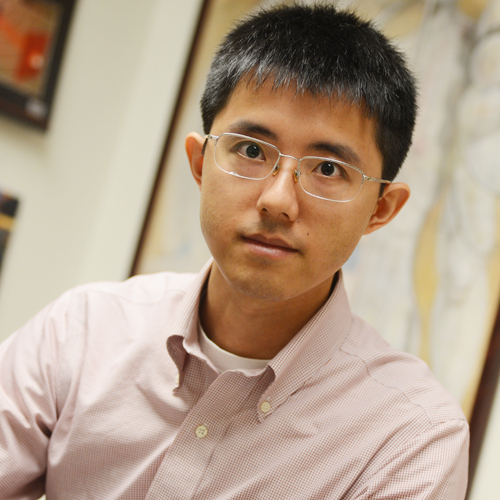Nanfang Yu | Leveraging Infrared Light to Create Novel Technology
 Nanfang Yu
Assistant Professor of Applied Physics
—Photo by Eileen Barroso
|
The world looks very different when illuminated by infrared light. This wavelength, which is outside the range of what human eyes can detect, has the promise to reveal more and detect different things than what we can see in visible light. For example, people and animals have elevated temperatures that emit stronger infrared light than their surroundings, so law enforcement professionals, military personnel, and hunters who wear night vision goggles can see them in the dark. Characteristic infrared absorption or emission spectra can be used to “fingerprint” chemicals or infer the chemical composition of a substance. Infrared light is robust against scattering and is the science behind navigation and communication systems used in foggy or dusty environments and behind security screening systems used for detecting concealed objects in luggage or mail. It also makes it possible to see deep into space and clearly study things that are light years away and shrouded by gas and dust.
“I am fascinated by the important and unique applications of mid-infrared and far-infrared light, which has a wavelength a few times to a few hundred times longer than that of visible light,” says Nanfang Yu, assistant professor of applied physics and investigator into the basic science and novel applications of infrared light. “Its full potential in chemical sensing applications, light detection and ranging, surveillance, communication, and energy has yet to be explored.”
Yu studies the interaction between light and structured active materials at the nanometer scale and builds novel devices including lasers, detectors, and active components for controlling light.
“I am constantly amazed by the fact that nanostructured materials usually turn out to be superb solutions for the generation, control, and detection of infrared waves with long wavelengths,” he says. “For example, quantum cascade lasers, the most popular coherent infrared light sources, are made of semiconductor superlattices, which comprise a stack of nanometer-thick semiconductors, the thinnest layer being only a few atoms thick.”
“In my lab, we are working to create a new class of flat optical components, the thicknesses of which are just one-thousandth of a human hair and yet are able to do all the jobs conventional, bulky optical components can do,” Yu explains. “These flat optical devices are made of a two-dimensional array of nano optical scatters, which can individually and abruptly change the amplitude, phase and/or polarization of the scattered light. Together, the array of scatterers can dynamically mold optical wavefronts into arbitrary shapes with ultra-high speed.”
Yu believes flat optics are the key to creating modulators for infrared light, which will open up completely new application areas such as all-weather free-space optical communication and remote-sensing optical radar.
To build better infrared detectors and communication systems, Yu probes the clever strategies developed by infrared-sensing organisms over their long evolutionary history. He is conducting interdisciplinary research with biologists and ecologists, exploring ways in which certain insects are able to detect broadband thermal radiation with extremely high sensitivity and spatial accuracy, or detect infrared “fingerprint” emissions from chemicals with high specificity. These studies will have a broad impact on novel heat-sensing devices and chemical detection systems.
Yu joined Columbia University in 2013 after completing his doctoral and postdoctoral work at Harvard University. At Harvard, Yu worked extensively on plasmonics, metamaterials, and mid-infrared and terahertz semiconductor lasers. He is a contributing member of a number of professional societies including the Optical Society of America, the IEEE Photonics Society, the American Physical Society, and the Materials Research Society.
BS, Peking University, Beijing, P. R. China, 2004; PhD, Harvard University, 2009
-by Amy Biemiller
